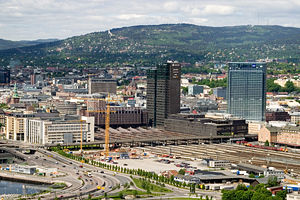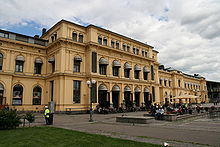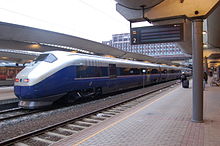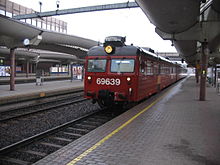- Oslo Central Station
-
Oslo Central Station 
Location Place Jernbanetorget Municipality Oslo Coordinates 59°54′40″N 10°45′3″E / 59.91111°N 10.75083°ECoordinates: 59°54′40″N 10°45′3″E / 59.91111°N 10.75083°E Line(s) Drammenbanen
Gardermobanen
Gjøvikbanen
Hovedbanen
ØstfoldbanenDistance 0.0 km Service Opened 1987 Architect John Engh IATA code XZO Owner Jernbaneverket Line operator(s) Norges Statsbaner
NSB Anbud
Flytoget
SJConnections 














Jernbanetorget
Oslo Bus TerminalOslo Central Station (Norwegian: Oslo sentralstasjon, abbreviated Oslo S) is the main railway station in Oslo and the largest railway station on the entire Norwegian railway system. It is the terminus of Drammen Line, Gardermoen Line, Gjøvik Line, Hoved Line and Østfold Line. It serves express, regional and local train services by four companies. The train station is owned and operated by Jernbaneverket and was opened in 1980.
Oslo Central was built on the site of the older Oslo East Station (Oslo Østbanestasjon, Oslo Ø), the combining of the former east and west stations being made possible by the opening of the Oslo Tunnel. Oslo Central has nineteen tracks, thirteen of which have connections through the Oslo Tunnel. The station has two buildings, the original Oslo East building and the newer main building for Oslo Central. Each building houses a large shopping centre. The square in front of the station is called Jernbanetorget.
Contents
History
Two stations
When the first railway line, Hoved Line, was built between Oslo and Eidsvoll in 1854[1] , the terminus in Oslo had been constructed as an ad-hoc solution located at Gamlebyen. Suggestions included Youngstorget, Grünerløkka and Vaterlands bru. In 1852 an architectural competition was announced, and won by a suggestion based on Crown Street Station in Liverpool. This station was located east of the river Akerselva and it was clear that this could not serve as a permanent solution, as it was close to neither the city centre or the port. In 1859 the freight section of the station was expanded with the purchase of land between Loelva and the port, and part of Bjørvika. The station experienced increased traffic from day one, but especially after the expansion of Hovedbanen to Hamar in 1862, and the opening of Kongsvingerbanen in 1865.
In 1872 Oslo got its second terminal station, located at Pipervika near Aker Brygge and the city hall. Oslo Vestbanestasjon (Oslo West Line Station or Oslo V) was built to allow Drammenbanen between Drammen and Oslo to terminate in downtown Oslo. The two stations were located about 2 km apart and were not connected by rail until 1907 when Havnebanen was built. There had been discussions about building a central station to connect Drammenbanen with the eastern station, but this idea involved building it via Majorstuen and Grefsen. Oslo V always remained a secondary train station in Oslo, since it mostly served local traffic to Buskerud, Telemark and Vestfold in addition to Sørlandsbanen.
A new East Line Station
The year after the western station opened, in 1873, the Norwegian legislature, the Storting, decided to build a new railway from Kornsjø at the Swedish border through Østfold to Oslo, Smaalenenebanen (now the Østfold Line). The traffic at the station was expected to explode due to this railway and it was decided that a new station had to be built. The engineers within NSB wanted to locate this new railway station west of the river Akerselva, between Jernbanetorget and Bjørvika. But a conflict arose between Carl Abraham Pihl, who was director of NSB at the time, and the City of Oslo. While Phil wanted a separate station for the Smaalenebanen, the city wanted to concentrate the stations in one place in Oslo. On the other hand, the engineers insisted on moving the station closer to the city. The architect Georg Andreas Bull made four suggestions for a new station with nine tracks over the river Akerselva. In 1878 the legislature decided to build the smallest suggested station—with only seven tracks over the river. The argument was that the station was overdimensioned. Oslo East Station (Oslo Østbanestasjon, Oslo Ø) opened in 1882.
Committee after committee
But it soon turned out that the station was too small. The population of Oslo had doubled to 150,000 between 1875 and 1890 and between the opening of the station and 1890 the traffic had increased from 400,000 passengers annually to more than a million, and the station was already too small. The most critical part was the freight section, where the trains had to partially use the main railway for switching. One of the proposed solutions to the problem was to build the line from Østfold on a viaduct into the station and elevate it on a level above the other tracks. Another problem arose in 1893 considering where the new Gjøvik Line was to terminate. Some suggestions implied a station at Grefsen with one line to Oslo East and one via Majorstuen to Oslo West. The Storting decided in 1895 that the Gjøvik Line was to be built to Oslo East.
To start the process of expanding the station, the Storting announced a competition in 1896, which was won by Sam Eyde. The main idea was that the freight section was to be moved away from the passenger sections to Lodalen. The suggestion was put to the vote in the Storting in 1899, and with 70 against 39 votes the new station was delayed because of the high projected costs. Instead they appointed another committee to look at other possible solutions. The committee was split in its final decisions, but both fractions concluded that a new railway had to be built between the two stations, and proposed a line past the city hall and in a tunnel underneath Akershus Fortress. But again the suggestion was watered out by the Storting and the only construction to take place was a new expedition for the Smaalenene Line and Gjøvik Line in addition to some minor changes to the freight section. The new railway line Havnebanen that connected the two stations opened in 1907.
The next major committee was created in 1938, and was to work out plans for what would become a central station. This was the first project to propose a tunnel under the entire city that would branch out from Drammenbanen before Oslo West. The committee proposed two suggestions, one where all traffic was directed to the new central station and one where the suburban traffic went to Oslo West. It also opened for construction of a line north of the city via Grefsen to Oslo East, but this was not recommended. The proposed tunnel below the city was proposed to be 1,660 metres long. The plans also included a twelve floor tall building for NSB's administration at the station, which at the time was spread around at 14 different places in the city. The committee delivered its proposal on December 7, 1939 to the Norwegian Ministry of Labour.
Wartime and change of plans
In 1940 after the German invasion of Norway in World War II the German puppet government in Norway took over control of transport planning in Norway and changed the plans in 1942 with the Tøyen Project. The idea involved dismantling both Oslo V and Oslo Ø and building a new central station at Tøyen. The idea was to concentrate all suburban transport to diesel buses while the trains were to be responsible for long distance transport. Tram and commuter train services were to be abandoned and the area freed was to be converted to freeways, so it would become less important to have the main train stations centrally located in the city. Both the committee and NSB rejected the project. During the war the German forces exploited the railway network and stock, and by the end of the war the entire railway system was worn out.
After the war, in 1946, the Planning Office for the Central Station was created, led by Egil Sundt. This committee announced an architecture contest for a new central station, and the suggestion Green Light by John Engh won. The planning office started work on planning the station based on the 1938 committee's work, and in addition decided to expand Alnabru Railway Yard in parallel with the railway station. The office presented plans in which it would take 15 years to complete. One of the greatest problems was the placement of the tunnel under the city. NSB wanted a straight line for quick transport while there on the other hand were extremely complex geological conditions in Oslo, including large areas of clay. The plans had originally included a station at Oslo City Hall, but a more northernly line was chosen that would be 1,802 meters long.
But passing the plans through the Storting proved difficult, even though the plans were presented in 1952. In 1959 the plans were revised and in 1960 a new committee was created. They suggested building a third line between Grefsen and Bestun for freight trains to connect between the eastern and western lines. It also felt that the tunnel should be expanded westwards and terminate somewhere between Skarpsno and Skøyen and at the same time close Havnebanen. The new plans were approved by the Storting in 1962.
One station
The new central station was to have the same basic plans as the suggestion that won the contest in 1946, though slightly modified, among other things keeping the old Oslo Ø building. The station was to have 19 tracks, of which 12 were to connect to the Oslo Tunnel. Construction of the new station started in 1979 and in 1980 the Oslo Tunnel could be taken into use. The tunnel got one of the planned stations, Nationaltheatret, while Elisenberg was never built due to lack of funds. Oslo S was taken into use on November 27, 1986 and officially opened by King Olav V on February 12, 1987. At the same time Oslo V was closed, and is now the seat for the Norwegian Nobel Institute.
Service
Four railway companies offer a combination of express, regional and commuter train service in addition to the Flytoget (Airport Express Train) service.
- Express trains are offered to Bergen, Kristiansand, Stavanger and Trondheim in addition to Stockholm in Sweden. Service is provided domestically by NSB using BM73 units and to Sweden by SJ using X2 units. Day trains are operated three times a day domestically and once to Stockholm. Night trains are also operated to all four cities mentioned before.
- Regional trains are operated to Skien, Lillehammer, Gjøvik, Halden, Karlstad and Gothenburg. Service is provided by NSB with BM70 units (Skien - Lillehammer), BM73b units (Halden - Gothenburg) and by NSB Anbud with BM69g units to Gjøvik. The Swedish PTA Värmlandstrafik operated by Merresor, using X53 "Regina" units on the Oslo - Karlstad service.
- Airport Express Train operates a ten-minute frequency to Oslo Airport, Gardermoen using BM71 units. This is the only high speed train service in Norway and is operated by Flytoget.
- Local trains are operated by NSB and NSB Gjøviksbanen using BM69 and BM72 units.
Connections
Oslo S plus Jernbanetorget is Norway's largest transport hub, served by buses, trams and subway.
- Connection to all six subway lines can be done through Jernbanetorget subway station
- Trams and some city buses stop outside the station at Jernbanetorget
- Long-distance bus termini are located 200 metres away at Oslo Bus Terminal
Preceding station Line Following station Nationaltheatret Drammenbanen Terminus Terminus Gardermobanen Lillestrøm Gjøvikbanen Tøyen Hovedbanen Bryn Østfoldbanen Nordstrand Preceding station Express trains Following station terminus Oslo S–Trondheim S Lillestrøm Oslo S–Stockholm C Asker Bergen–Oslo S Terminus Kristiansand–Oslo S Preceding station Regional trains Following station Nationaltheatret
or TerminusAirport Express Lillestrøm or
Oslo AirportTerminus Oslo S–Halden Ski Nationaltheatret Skien–Oslo S–Lillehammer Lillestrøm Terminus Oslo S–Gjøvik Grefsen Preceding station Local trains Following station Nationaltheatret
or Terminus300 Skøyen–Oslo S–Jaren Tøyen 400 Asker–Oslo S–Lillestrøm Bryn 440 Drammen–Oslo S–Dal Lillestrøm 450 Kongsberg–Oslo S–Eidsvoll 460 Skøyen–Oslo S–Kongsvinger 500 Skøyen–Oslo S–Ski Nordstrand 550 Spikkestad–Oslo S–Moss Kolbotn 560 Skøyen–Oslo S–Mysen Holmlia Stations Closed stations Unused stations Branch lines Tunnels Oslo Airport Express Train (Flytoget) General GMB Class 71 · Oslo Airport, Gardermoen
Lines Stations Drammen · Asker · Sandvika · Lysaker · Skøyen · Nationaltheatret · Oslo Central · Lillestrøm · Oslo Airport StationExternal links
- Jerbaneverket's entry on Oslo Central (Norwegian)
- NSB's entry on Oslo Central
- Flytoget's entry on Oslo Central
- Norsk Jernbaneklubb's entry on Oslo Central (Norwegian)
- Website presenting the Oslo Central Station, shops, restaurants etc (Norwegian)
References
Categories:- Railway stations in Oslo
- Railway stations on Drammenbanen
- Railway stations on Gardermobanen
- Railway stations on Gjøvikbanen
- Railway stations on Hovedbanen
- Railway stations on Østfoldbanen
- Railway stations opened in 1987
- 1987 establishments in Norway
- Flytoget
Wikimedia Foundation. 2010.




